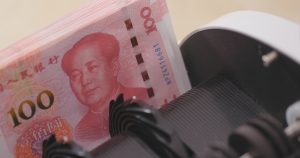China’s economy has faced major disruptions through 2021 due to the ongoing China-U.S. trade war, COVID-19 restrictions, and power shortages. While the economy may continue to suffer from the ongoing trade war and possible COVID-19 resurgences, new issues are likely to rise to the forefront of economic problems in 2022. These include combating the real estate downturn and inflation, as well as bringing about common prosperity. However, risks are likely to be tightly controlled due to the upcoming 20th Party Congress in the second half of the year, as Xi Jinping is widely expected to notch a third term in office.
Ongoing Real Estate Downturn
China’s real estate developers suffered through 2021 due to increased financial restrictions, which led some developers, most famously Evergrande, to default on some debt repayments. Commercial sales and real estate investment growth have slowed down. Debt among property developers will continue to pose a barrier to achieving financial health in this sector.
The economic work meeting laid out the need to promote the construction of affordable housing and adjust the commercial housing market to better meet buyers’ housing needs. This industry represents a key investment channel for consumers, and falling home prices are quickly shored up by local government policies. At the same time, consumers often face challenges in purchasing new homes due to the higher prices, which the government attempts to address by encouraging the construction of affordable housing.
The question surrounding China’s real estate downturn is the extent to which debt defaults will impact the rest of the financial sector as well as domestic investors. The government has signaled that it is willing to ease financial terms to some extent in order to reduce fallout; in December, the central bank lowered the loan prime rate and reserve requirement ratio in order to increase bank lending to creditworthy customers. Meanwhile, it appears unlikely that the government will directly bail out indebted developers, choosing to use monetary tools in order to ease the accompanying credit crunch. The government has also encouraged banks to help healthy developers acquire distressed developers’ projects.
Inflation
Producer price inflation created rising prices in 2021 without heavily impacting consumer price inflation. This was due to high commodity prices and transportation bottlenecks, combined with labor and energy shortages. Supply chain disruptions are likely to continue somewhat into 2022, easing by the second half of the year as interruptions due to COVID-19 and surging demand stabilize. In addition, China’s power shortages due to emissions restrictions will be reset in 2022, and production plans are likely to be adjusted.
Producers have begun to pass through higher costs to consumers, resulting in a slight rise in consumer price inflation. Somewhat increasing food prices have also resulted in higher CPI. Rising demand ahead of Chinese New Year is expected to result in a higher CPI to some extent in January. In addition, inflation in the United States and the European Union is likely to be transmitted to China through rising import prices. Therefore, although CPI remains much lower than PPI, CPI is likely to rise in 2022.
Common Prosperity
Xi Jinping has continued to underscore the importance of “common prosperity,” which involves cultivating quality and more egalitarian economic development. Along with this, China ushered in a slew of regulations in 2021, some of which cracked down on monopolistic firms and their anti-consumer practices. Already, the campaign has induced wealthy individuals and firms to donate to charity in an attempt to reduce economic inequality ahead of further government regulations.
The drive for common prosperity will continue to gain force through 2022, although how it will be translated into specific policies remains somewhat unpredictable. More regulations to control excessive and “unfair” economic gains and policies to reduce inequality may come into effect.
Slowing Growth
The Chinese government has prioritized economic stability for 2022. Han Wenxiu, deputy director of the Office of the Central Committee of Finance and Economics, stated after the Central Economic Work Conference that officials must be cautious in introducing policies that have an economic tightening effect.
The World Bank has set China’s 2022 growth forecast to 5.1 percent, a much slower pace of growth than China averaged in previous decades. China is likely to shore up GDP by investing, once again, in fixed assets. Infrastructure investment will comprise a large part of this. The country will probably issue more special bonds in order to partly finance fiscal spending.
The Beijing Winter Olympics to be held in February will also stimulate the economy to some extent. New technology industries such as new energy vehicles and industrial robots will continue to provide a source of economic growth. Technologies that help China to move closer to carbon neutrality will also provide growth support. Even so, China’s economy will continue to face headwinds as it battles a flagging real estate sector and inflation, coupled with geopolitical forces such as the China-U.S. trade war and technology tensions.

































